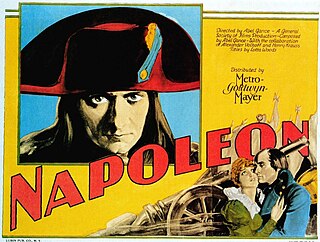
Napoléon is a 1927 French silent epic historical film, produced and directed by Abel Gance, that tells the story of Napoleon's early years.

Abel Gance was a French film director, producer, writer and actor. A pioneer in the theory and practice of montage, he is best known for three major silent films: J'accuse (1919), La Roue (1923), and Napoléon (1927).
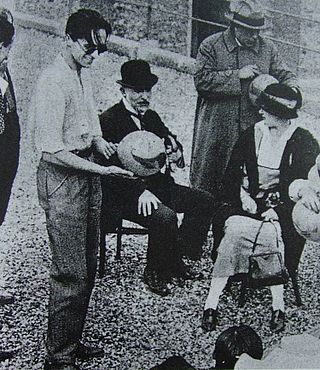
René Clair, born René-Lucien Chomette, was a French filmmaker and writer. He first established his reputation in the 1920s as a director of silent films in which comedy was often mingled with fantasy. He went on to make some of the most innovative early sound films in France, before going abroad to work in the UK and USA for more than a decade. Returning to France after World War II, he continued to make films that were characterised by their elegance and wit, often presenting a nostalgic view of French life in earlier years. He was elected to the Académie Française in 1960. Clair's best known films include Un chapeau de paille d'Italie, Sous les toits de Paris, Le Million (1931), À nous la liberté (1931), I Married a Witch (1942), and And Then There Were None (1945).

The Cinémathèque française, founded in 1936, is a French non-profit film organization that holds one of the largest archives of film documents and film-related objects in the world. Based in Paris's 12th arrondissement, the archive offers daily screenings of films from around the world. It is the second oldest cinematheque in France, after the one in Saint-Étienne, which was founded in 1922.

Jacques Feyder was a Belgian film director, screenwriter and actor who worked principally in France, but also in the US, Britain and Germany. He was a director of silent films during the 1920s, and in the 1930s he became associated with the style of poetic realism in French cinema. He adopted French nationality in 1928.

Françoise Rosay was a French opera singer, diseuse, and actress who enjoyed a film career of over sixty years and who became a legendary figure in French cinema. She went on to appear in over 100 movies in her career.
Lazare Meerson (1900–1938) was a French cinema art director. After emigrating from Soviet Russia in the early 1920s, he worked on French films of the late silent cinema and the early 1930s, particularly those directed by René Clair and Jacques Feyder. He worked in England during the last two years of his life. He had great influence on film set design in France in the years before World War II.

Jean Grémillon was a French film director.

Carnival in Flanders is a 1935 French historical romantic comedy film directed by Jacques Feyder, and created during the poetic realism period in 1930s France. It is also widely known under its original title in French, La Kermesse héroïque. A German-language version of the film was made simultaneously and was released under the title Die klugen Frauen, featuring Ernst Schiffner in one of his early film roles.

Charles-Marie Vanel was a French actor and director. During his 65-year film career, which began in 1923, he appeared in more than 200 films and worked with many prominent directors, including Alfred Hitchcock, Luis Buñuel, Jacques Feyder, and Henri-Georges Clouzot. He is perhaps best remembered for his role as a desperate truck driver in Clouzot's The Wages of Fear for which he received a Special Mention at the Cannes Film Festival in 1953.

Cœur fidèle is a 1923 French drama film directed by Jean Epstein. It has the alternative English title Faithful Heart. The film tells a melodramatic story of thwarted romance, set against a background of the Marseille docks, and experiments with many techniques of camerawork and editing.

Gina Manès was a French film actress and a major star of French silent cinema. After an early appearance in a Louis Feuillade film, she had significant roles in films of Germaine Dulac and Jean Epstein, including Cœur fidèle.

J'accuse is a 1919 French silent film directed by Abel Gance. It juxtaposes a romantic drama with the background of the horrors of World War I, and it is sometimes described as a pacifist or anti-war film. Work on the film began in 1918, and some scenes were filmed on real battlefields. The film's powerful depiction of wartime suffering, particularly its climactic sequence of the "return of the dead", made it an international success and confirmed Gance as one of the most important directors in Europe.
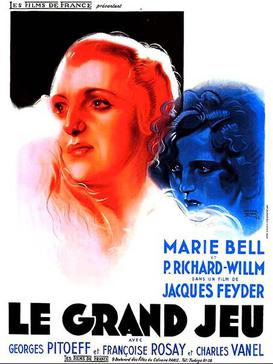
Le Grand Jeu is a 1934 French drama film directed by Jacques Feyder and starring Pierre Richard-Willm, Marie Bell, Charles Vanel and Françoise Rosay. It is a romantic drama set against the background of the French Foreign Legion, and the film was an example of poetic realism in the French cinema. The title Le Grand Jeu refers to the practice of reading the cards. Blanche asks whether her client wants the 'full works', the whole story: "Alors... je te fais le grand jeu?"
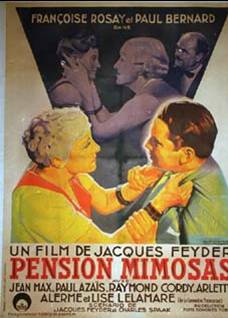
Pension Mimosas is a 1935 French drama film directed by Jacques Feyder. Based on an original scenario by Feyder and Charles Spaak, it is a psychological drama set largely in a small hotel on the Côte d'Azur, and it provided Françoise Rosay with one of the most substantial acting roles of her career. It was produced by the French subsidiary of the German company Tobis Film.
Marie-Antonine Epstein was an actress, scenarist, film director, and film preservationist. Her career is distinguished by three important collaborations. Throughout the 1920s, she acted in and wrote scenarios for films directed by her brother, Jean Epstein. From the 1920s through the early 1950s, she collaborated with the director Jean Benoît-Lévy on sixteen films, serving variously as a writer, assistant director, and co-director. From the early 1950s to her retirement in 1977, Epstein served as a film preservationist at the Cinémathèque française.
Léonce-Henri Burel was a French cinematographer whose career extended from the silent era until the early 1970s. He was the director of photography on more than 120 films, working almost exclusively in black-and-white.
Films Albatros was a French film production company established in 1922. It was formed by a group of White Russian exiles who had been forced to flee following the 1917 Russian Revolution and subsequent Russian Civil War. Initially, the firm's personnel consisted mainly of Russian exiles, but over time, French actors and directors were employed by the company. Its operations continued until the late 1930s.
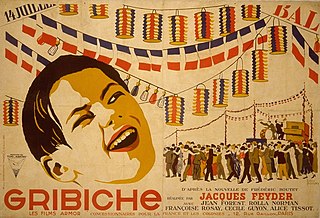
Gribiche is a 1926 French silent film directed by Jacques Feyder based on the eponymous short story by writer Frédéric Boutet.
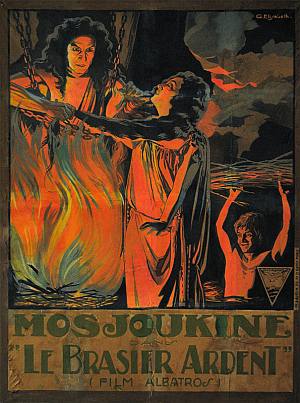
Le Brasier ardent is a 1923 French film directed by Ivan Mosjoukine. It combines elements of comedy, mystery, romance and psychological drama. The title has been variously translated into English as The Blazing Inferno, The Burning Crucible, The Burning Brazier, The Burning Cauldron, and Burning Embers.
















